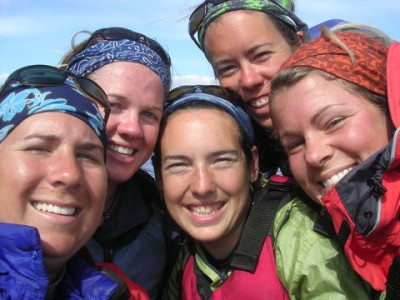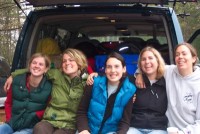07/08/2005, GPS Coordinates: 63°, 22

Dubawnt Lake, Tulemaliguak, in Inukituk, is the sixth largest lake in Canada. Straight across it is 60 miles from where the Dubawnt River flows in at the southwest corner and Outlet Bay where it again heads north.
On the morning of July 8th, we wake early in a small, sandy cove bordered by high rocky points somewhere on the northwest shore. For the past four days we have been tracing the shoreline, forced by the ice to explore every small nook and cranny and occasionally portage over a thin peninsula to save dragging around it. This morning the lake is shrouded in a heavy fog. Behind me the tundra fades to white. In front, the gray ice that lies about 100 feet offshore is barely visible. We stumble through the methodical process of breaking camp and shiver quietly over a breakfast of sweet rice, slowly regaining circulation and life as the strong, black coffee seeps into us.
Before 7:30 a.m., we are pushing off into the fog and heading north. The shadows of steep, rocky points loom ahead like ghosts and the tiny, rain gorged streams, draining the tundra, fill the still air with a soft rush. The wind was fierce and from the north yesterday, so while most of the shoreline has a small cache of open water, the north side of many of the little points is choked with ice. I am paddling in the bow of one canoe with Emily. When we come to one of these points, either she or I stand up and pick the line. Sometimes, with patience and our rather large biceps, we can move surprisingly huge pieces of ice out of the way and clear a channel. If the ice cannot be moved, it is one of two types: ice we can stand on or ice we can't. If we can't stand on it, the best strategy is to pick up speed and break through as much of it as possible before losing momentum. From there, the bow person can either chop a path clear with her paddle or choose Beth's signature move, affectionately called the rototill, wherein one balances on the bow of the boat and leans back, flailing at the ice with her heavy heeled Choda boots. If the ice is thick enough to stand on, we haul the whole boat up and push it over like a bobsled. If we're unsure about the wisdom of standing on the ice, both bow and stern's woman and the duffer, if necessary, push the canoe forward while straddling the gunnels so as to be sure to fall into the boat if we've judged incorrectly. Our technique for tackling the ice evolves on a daily basis and has inspired far more laughter than frustration over the last six weeks.
This morning the lake is kind and the ice only occasional. Emily and I are talking about our plans for life post-BPE. As neither of us has a job or even a definite location for the fall, this is an inexhaustible source of conversation. We dream big and make up preposterous names for the plans, which we'll have revised by tomorrow. The fog lifts slightly only to bring a heavy, bone chilling rain and twice we pull off the water due to lightening. Thunderstorms are rare in the tundra and leave one feeling a little absurd. Though there are hills and high ridges, and the ground is often covered with large rocks, it is difficult to avoid being the tallest thing around.
We spread out as best we can and eat our Snickers bars. Yes, it's only 10:30 and we do some sort of improvised Tai-Bo that involves a lot of giggling. The morning flies by and suddenly it is time for lunch. The fog still hangs low and white on some of the ice, but the sky has mostly cleared and we lay out our many layers to dry, make another round of hot drinks and lament our dwindling supply of peanut butter. Our aching bodies plea for rest, but Karen reminds us of our ambitious goal for the day, due to our eagerness to get to Outlet Bay and the re-supply. Though we have plenty of food, we are running low on a few essentials: Snickers bars, salsa and dehydrated bananas; and so we move on.
Throughout the afternoon, huge violet storm clouds chase us along the shoreline again forcing us to pull off and wait a couple of times. In the sunlight the incredible array of colors around us is suddenly apparent. The green tundra is carpeted with purple rosebay and pink alpine azalea. And the huge rocks lining the shore are covered in flame orange, white and deep green lichens. The dark and threatening clouds leave a vivid rainbow in their wake and even the ice takes on different hues. Where huge pieces push up on top of each other, they are a pale blue mirroring the sky. Where ice remains stuck to the lake bottom, it glows an eerie light green below the water.
Conversation ranges from what to eat for dinner to how to appease the Dubawnt weather gods. Ever since arriving on the lake, we've had wild and capricious weather, the most impressive of which was a 4th of July wind storm that sent our well-beached boats flying through the air. Emily and Meg caught them with a mix of super human speed and luck. That evening we were able to retreat to our cozy EMS Tundra Dome tent, but on those many occasions that we are out in the elements, we've been covered head-to-toe in our Kokatat Paclite jackets and pants. This durable and light rain gear keeps us dry and stylish in the worst rain and on those all too common occasions when a misstep sends icy water flooding into our boots, our feet remain warm and blister free thanks to our Wigwam rugged wool hiker socks. In the afternoon we drag over two longer stretches of ice to cut off frozen bays but find the last stretch mercifully open. The arctic sun is still high in the sky, but I can feel the late hour in my back and shoulders and in the energy of the group. The two boats paddle side-by-side, the silence broken open by Meg's navigational direction from the duffer seat.
We find a camp site among the rocks on the shore, and we huddle in our Cooke Custom Sewing tundra tarp safe from the voracious mosquitoes. Emily cooks pasta for dinner while I fry up a mean batch of potato pancakes to eat cold in the morning. Meg works on cleaning our temperamental stove for the thousandth time. Beth tries over and over to fit all of our maps into our map tube (thanks again Steve Davis), while Karen repairs the well-warn map case we use during the day. We should have known better than to let Emily, who gets some sort of strange satisfaction from finishing off bags of food, cook without anyone else paying attention. Everyone, even Karen, who is known to cook a few big pot meals herself, is astounded by the quantity of food. We eat well, share a good laugh at a song Meg has improvised in a falsetto voice about her chocolate craving and retreat hastily to our tents. Karen and I trade backrubs and she is instantly asleep as is Beth, who I can hear snoring in the distant tent. I open the tattered pages of my journal and stare out the vestibule at the slowly setting sun. As I write these words I am again beneath the tundra tarp, tired but warm and satisfied at the end of another long day.
Over the last two days we have been hitting more ice and we have to drag or portage much of the distance. Nevertheless, we are only 25 miles from re-supply, a day's paddling or a day and a half of dragging. Today we had the excitement of being flown over by a float plane heading for Tusco Lodge in Outlet Bay. Meg was able to talk to the pilot on our live site radio and he came in for a couple of close passes, apparently as amused by the sight of five women standing in the middle of the ice as we were excited to see him. We whooped and hollered as he roared by our heads and headed northwest, probably blushing as Meg made some cheeky comment on what an attractive Twin Otter he had. We are planning on picking up our food on the 13th and are happy to know our Snickers bars are there waiting for us along with at least enough water to land a plane in.
As we near the halfway point of our trip, our conversation and thoughts often turn to our families and friends at home and at Manito-wish. We hope your summer has gone well thus far and is slightly warmer than ours. Know that we are happy, healthy and continuing to enjoy every moment of this wild journey.
View Photos (received from the first resupply)
CLICK HERE
Support the Borealis Campership Fund at Camp Manito-wish YMCA
